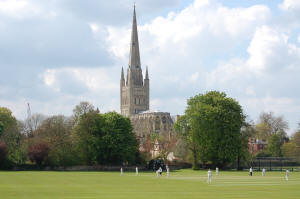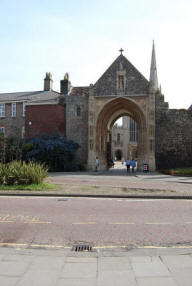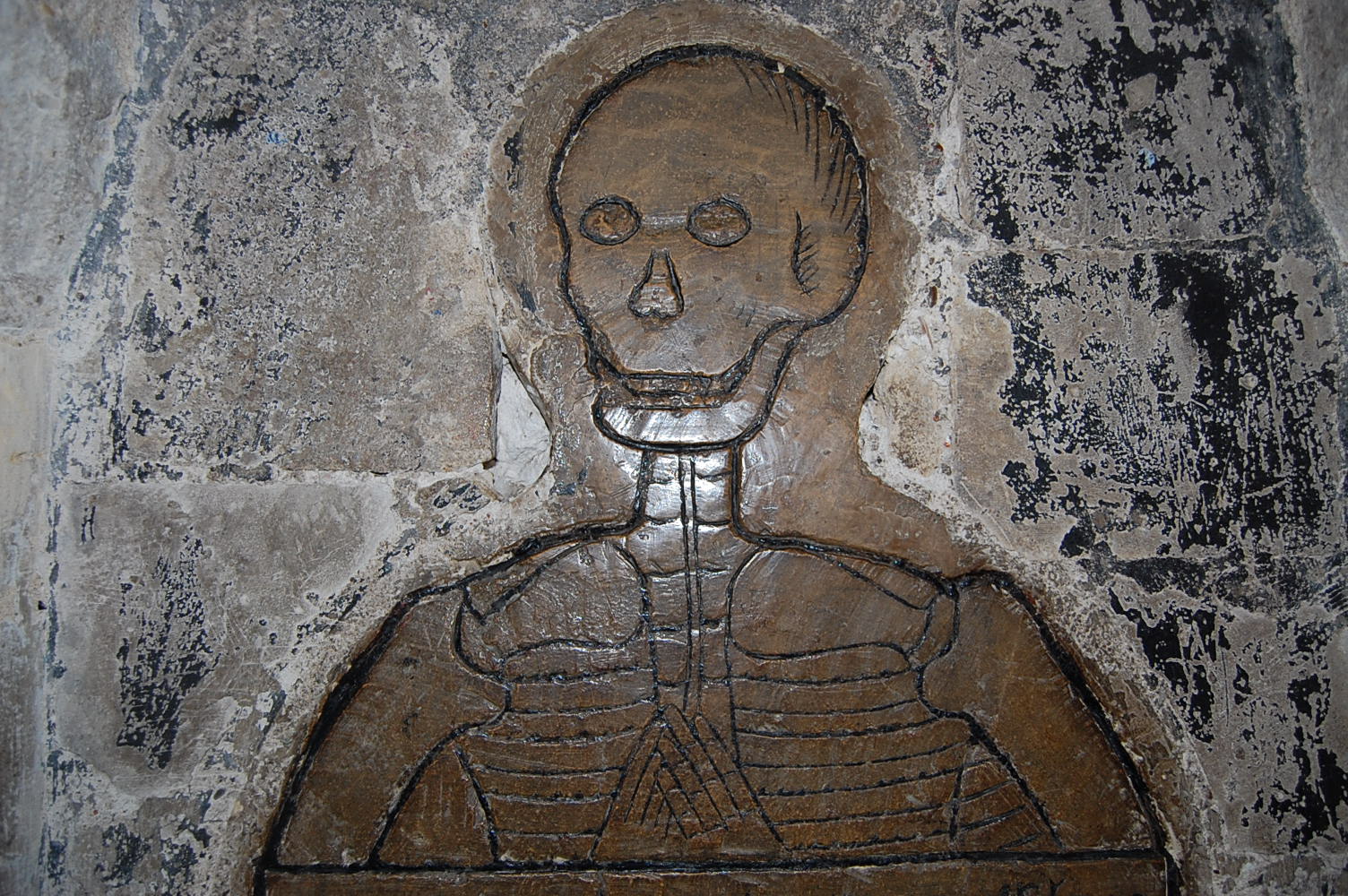|
|
| Norwich Cathedral Norwich Cathedral is located in a hollow inside a
loop of the River Wensum.
It was founded in 1096 by Herbert de Losinga who, as a
penance, was required to move his see from
Thetford to Norwich.
The
cathedral, which is one of the most distinctive
buildings in the county, is constructed from Caen stone
- brought to Norfolk from Brittany by boat along the
River Yare. Originally
there was a canal between Pull's Ferry and the cathedral
along which the stone was transported. At 315 ft, the spire is the
second highest in England after Salisbury cathedral.

Norwich Cathedral
The cathedral close is home to the
Norwich School - whose
ex-pupils include George
Borrow, Augustus Jessopp (see
Scarning), D. J. Taylor and the poet Robert Greene.
The cathedral itself also has a number of literary connections:
|
|
Sir Thomas Erpingham (1357-1428) Thomas
Erpingham, who led the English archers at the Battle of
Agincourt and who was immortalised by Shakespeare in his
play Henry V, was responsible for constructing the Erpingham Gate in about 1420. On the gable of the gate
there is a sculpture of him, kneeling and praying.

The Erpingham Gate According to Sir
Thomas Browne, Erpingham and his two wives (both
called Joan) are buried inside the cathedral next to
Queen Elizabeth's seat. However, today it is thought
that Sir Thomas is actually
buried at Erpingham.
|
|
Thomas Tusser (?1524-1580) After leaving his
farm at West Dereham
the poet
Thomas Tusser moved to Norwich Cathedral where he
obtained a job as a lay clerk - thanks to the good
offices of John Salisbury. He recorded his impressions
of the city in his verse autobiography The Author's
Life :
|
At length by yew,
to shore I drew,
Discharging straight both ship and fraight,
At Norwich fine, for me and mine,
a citie trim:
Where strangers wel may seeme to dwel,
That pitch and pay, or keepe their day,
But who that want, shall find it scant
so good for him. |
While in Norwich Tusser experienced a stoppage of the
bladder which made him unable to pass water for 138
hours. After leaving the city he returned to farming at
Fairstead in Essex.
|
|
Thomas Gooding
Thomas Gooding was buried vertically inside Norwich
Cathedral - in order that he could
spring up and be first into heaven. His tomb is now known as 'the
skeleton'.

The Skeleton
It features a wonderfully
poetic epitaph:
|
All you that do
this place pass bye
Remember death for you will dye.
As you are now even so was I
And as I am so shall you be.
Thomas Gooding here do staye
Wayting for God's judgement day. |
Richard Corbett (1582-1635)Richard Corbett was
educated at Christ Church, Oxford and later became
Bishop of Oxford. In 1632 he became the Bishop of
Norwich. He was noted for his satirical
verse and ballads. His work was widely circulated in
manuscript form during his lifetime but little (with the
exception of his Latin verses) was actually published.
During his spell as Bishop he tried to ban the
'strangers' from the cathedral - i.e. Dutch and Walloon
refugees who had sort sanctuary in the city.
His final words were 'Good night, Lushington' - which
were spoken to his chaplain. Corbett is buried inside
the cathedral.
He is best remembered for A Proper New Ballad,
entitled The Fairies Farewell.
|
|
Henry Charles Beeching (1859-1919) Another poet
who lies inside the cathedral is Henry Charles Beeching.
His ashes were interred at the back of the apse behind
the high altar. Mourners at his funeral included the
poet laureate Robert Bridges.
Beeching, who published several volumes of poetry,
was the Dean of the cathedral. He is particularly
remembered for his poem the Boy's Prayer.
In 1913, he also delivered a sermon in the cathedral
about the Norfolk-born writer
George Borrow.
|
|
L.P. Hartley (1895-1972) In
The Go-Between
Leo Colston visits Norwich with Marian Maudsley in
order to buy some
new clothes. While in the city Leo walks round Tombland
and the
cathedral - and his time in the city
is crucial to his development as a character:
|
|
'My spiritual
transformation took place in Norwich: it was there that,
like an emerging butterfly, I was first conscious of my
wings.' |
In his film of the book, the director Joseph Losey's uses
many of the actual
locations from the novel including: the interior of the
cathedral, the cloisters, the Cathedral Close and the
nearby
Maid's Head Hotel.
The cathedral also provided a location for the off-beat
2008 film Dean Spanley which starred Peter
O'Toole.
|
|
John Gordon (1925- The Close appears in
Gordon's first novel The Giant Under the Snow
(1968). Gordon was working at Eastern Counties
Newspapers in the city while he was writing the book and
there are a number of Norfolk locations involved. The
book is a children's fantasy adventure about a magical
Celtic buckle. |
Links:
More Norwich Cathedral Photographs
|

